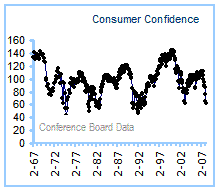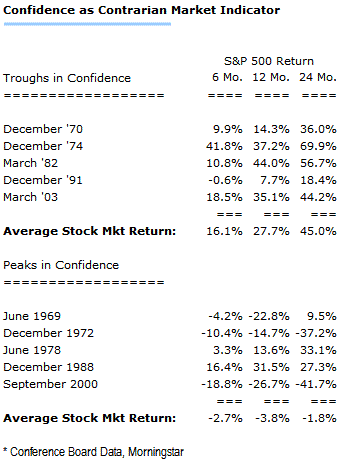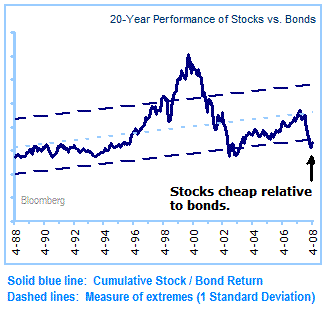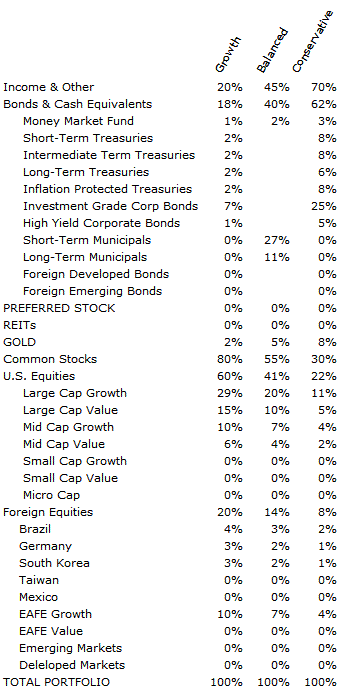Buy The Dips
"If no one ever took risks, Michelangelo would have painted
the Sistine floor."
- Playwright Neil Simon
In managing portfolio risk, there is always a balance
between risk-taking and care-taking of assets. Taking risk
is certainly laudable, but we believe taking calculated
risks is a far preferable way to approach portfolio
decisions and tactical asset allocation.
Over the past year, we have seen rising risks to the economy and
markets have adjusted in response. Readers of our commentary
know that we have been paying close attention to the supply
and demand for credit in the economy; the rate of growth in
private sector employment; the supply of unsold houses as a
leading indicator of growth; and corporate profits and cash
flow. Each of these indicators remains weak.
However, we must weigh against these risks the prospects
for returns over the horizon. Thus, even though the above
mentioned trends remain negative, we now believe that
investors should gradually seek to add riskier assets on
"dips" because negative news on housing and the economy has
become better understood and equity valuations have become
far more attractive when compared to bonds and hard assets.
Facts are stubborn things. Today, bank write-offs have
exceeded $340 billion, while new assets raised have amounted
to only $260 billion. Net new demand for credit throughout
the economy, which once was growing at high double-digit
rates, has slowed to a low-single-digit trickle. Private
sector jobs are down 326,000 from November's peak and up
only 0.2% over this time last year. The supply of homes for
sale is 70% above normal, and further price erosion is
expected. Corporate profits are expected to be down 16% for
the first quarter – led by declines in financials and the
consumer sector. Almost none of this was expected a year ago
when forecasts for growth were high and risk was
systematically priced out of many markets (see our
March 19, 2007 and
June 15, 2007 Market Comments for more on this).
While this assessment of the economy is sobering, markets
remain flexible and are forward-looking. Therefore, while
current trends remain negative, we are adjusting our
portfolio posture to allow for the gradual addition of
riskier assets to portfolios on "dips" because negative news
on housing and the economy has become commonly accepted.
 The
bad news on housing, rising energy costs, and employment can
now be plainly seen in the data on consumer confidence. The
most recent survey measure taken by the Conference Board
shows that consumer confidence has dropped to levels that
typically coincide with past recessions (see graph). The
unrelenting and ongoing stream of negative economic news has
become part of today’s landscape and the appreciation for
downside risk is now much better understood than it was a
year ago. The
bad news on housing, rising energy costs, and employment can
now be plainly seen in the data on consumer confidence. The
most recent survey measure taken by the Conference Board
shows that consumer confidence has dropped to levels that
typically coincide with past recessions (see graph). The
unrelenting and ongoing stream of negative economic news has
become part of today’s landscape and the appreciation for
downside risk is now much better understood than it was a
year ago.
This adjustment in attitudes is a good proxy for profit
expectations, which also are coming down, as earnings for
the second quarter are now expected to be down 7% versus a
+4.7% expected growth rate at the start of the year. We also
know that the 34% underperformance by stocks (the S&P 500
index was down 16%) relative to bonds (long-term Treasury
bonds were up 18%) between July 12, 2007 and March 17, 2008
represents a historic re-pricing of risk. This 34% relative
adjustment is in the realm of magnitude of past re-pricing
episodes including the 1973 OPEC oil embargo (a 40% relative
adjustment); the 1980-81 credit shock (a 30% adjustment);
the 1987 stock market correction (a 32% adjustment); and the
bursting of the tech bubble in 1999 (a 61% adjustment).
These pricing adjustments, while painful and generally
accompanied by negative news, often yield to better times
for investors.
To demonstrate this, we return to the Conference Board data
on consumer confidence. Recently, we examined how equity
markets have historically performed following major low
points in confidence. Not surprisingly, we found that equity
markets did well in the six, twelve, and twenty-four month
periods following such lows (see table).

As the table above shows, from times of maximum distress in
confidence, large-cap stocks returned 27.7% in the ensuing
12 months from the trough, on average. By contrast,
investing during times of high confidence often led to
disappointing results and produced an average -1.8% over the
next 12 months following peak levels. The current low
readings on confidence suggest that we may be nearing a
turning point for equities.
The most important reason investors should gradually add to
riskier assets on "dips" is because equity valuations are
currently cheap compared to bonds and hard assets.
Here, we consider the 20-year relationship between the
performance of the S&P 500 index (representing stocks) to
long-term Treasury bonds (representing bonds). On a total
return basis, we see that stocks have only returned a modest
1% per-annum excess return over the U.S. Treasury asset.
This may suggest that the "irrational exuberance" of the
late-1990s that caused the boom (and bust) in equities has
run full course and that we may be entering a new cycle of
out-performance by equities. At a minimum, it is difficult
to label the equity market as irrationally exuberant
(although it could imply that bonds are).

Note: Indices are unmanaged. You cannot
invest directly in an index.
But, U.S. financial assets seem to have quickly become far
less expensive relative to hard assets. We see this across a
variety of categories, including metals, energy, and
agricultural commodities. Some of this is a function of
rising global standards of living, but we believe that at
least as much of the increase is caused by an
underinvestment in the commodity supply chain (due to years
of poor returns) coupled with portfolio shifts away from
dollar-denominated financial assets. Since April 2000, for
example, equities (S&P 500 index) have underperformed gold
by 60%, with most of this underperformance occurring over
the past three years. In the process, financial assets such
as equities have arguably become more attractively valued by
comparison.
So you can see that although employment, housing, credit,
and profit trends remain negative, we believe portfolios
should tactically add to riskier assets on "dips" for two
main reasons. First, negative news on housing and the
economy has become commonly accepted knowledge. But most
importantly, equity valuations have improved materially
compared to bonds and hard assets and the recent re-pricing
of risk from July, 2007 through March, 2008 has been of
historically significant proportions.
If we are right about our evaluation, investors − like the
builders of the Sistine Chapel − will be rewarded for
patience and prudent risk-taking by gradually modifying
their portfolio posture to emphasize riskier assets over
defensive ones during this difficult period, despite what
will likely be negative ongoing headlines.

|
Past Commentaries
March 10, 2008
Investing During Recession
More
January 22, 2008
Global Sell-off
More
December 27, 2007
Outlook 2008
More
December 7, 2007
NBER President Raises Recession Concerns
More
November 28, 2007
Equity Risk Heightened - Allocation Remains Defensive
More
September 25, 2007
After the Rate Cut
More
July 30, 2007
The Case For Growth
More
June 15, 2007
Data Affirms Tactical Asset Allocation Posture
More
March 19, 2007
Cutting Earnings And Equity Target
More
| |
To unsubscribe, please click here.
Company Name, Address and Contact Details
The information contained herein has been prepared from sources believed to be
reliable but is not guaranteed by us and is not a complete summary or statement
of all available data, nor is it considered an offer to buy or sell any
securities referred to herein. Opinions expressed are subject to change without
notice and do not take into account the particular investment objectives,
financial situation, or needs of individual investors. There is no guarantee
that the figures or opinions forecasted in this report will be realized or
achieved. Employees of Stifel, Nicolaus & Company, Incorporated or its
affiliates may, at times, release written or oral commentary, technical
analysis, or trading strategies that differ from the opinions expressed within.
Past performance is no guarantee of future results. There are special
considerations associated with international investing, including the risk of
currency fluctuations and political and economic events. Investing in emerging
markets may involve greater risk and volatility than investing in more developed
countries. Due to their narrow focus, sector-based investments typically exhibit
greater volatility. Small company stocks are typically more volatile and carry
additional risks, since smaller companies generally are not as well established
as larger companies. Property values can fall due to environmental, economic, or
other reasons, and changes in interest rates can negatively impact the
performance of real estate companies. When investing in bonds, it is important
to note that as interest rates rise, bond prices will fall. High-yield bonds
have greater credit risk than higher quality bonds. The risk of loss in trading
commodities and futures can be substantial. You should therefore carefully
consider whether such trading is suitable for you in light of your financial
condition. The high degree of leverage that is often obtainable in commodity
trading can work against you as well as for you. The use of leverage can lead to
large losses as well as gains. Indices are unmanaged, and you cannot invest
directly in an index.
Stifel, Nicolaus & Company, Incorporated | Member SIPC & NYSE |
www.stifel.com |